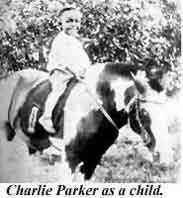Bird levantou voo há 50 anos

[Desenho da autoria de Gene Levin]
Completam-se hoje 50 anos sobre a morte de Charlie Parker, o pai do jazz moderno e uma das poucas figuras, juntamente com Louis Armstrong e Miles Davis, de que se pode dizer que mudou a face do jazz de forma permanente.

[Notícia do New York Times, de 15/3/1995]
Sobre Parker e a sua importância no jazz já muito se escreveu ao longo dos anos, mas no site oficial do saxofonista encontra-se sintetizada a sua importância para o jazz:
Parker redefined the world of jazz; his complex rhythms and
improvisational style influenced musicians and changed the landscape of music forever.
Parker não só foi inovador tecnicamente no saxofone alto, como ritmicamente e harmonicamente, sendo, com Dizzy Gillespie e Bud Powell, um dos pais do bebop.
Nascido em Kansas City em 29 de Agosto de 1920, Parker aprendeu com mestres como Lester Young, Bster Smith e Art Tatum (em 1939 Parker arranjou emprego num restaurante de NYC, onde lavava pratos para poder ouvir, noite após noite, este genial pianista, que ali costumava tocar), tendo composto temas emblemáticos como «Now's The Time», «Anthropology», «Confirmation», «Ornithology», «Scrapple From the Apple», «Ko-Ko ou «Parker's Mood». Muitos destes temas mais não eram do que melodias colocadas sobre a estrutura harmónica de velhos standards, posteriormente modificada por Parker, tornando-se bem mais complexa. «Scrapple from the Apple», por exemplo, resultou da combinação harmónica de dois temas: «Honeysuckle Rose» (de Fats Waller) e «I Got Rhythm».
A vida de Parker, musicalmente e pessoalmente não foi fácil e noi início incluiu várias humilhações em jam-sessions protagonizadas por músicos mais velhos. Uma das cenas mais marcantes sucedeu quando o saxofonista, com apenas 16 anos, entrou numa jam-session em Kansas City. O baterista Jo Jones conduzia a sessão e descontente com a prestação musical de Parker atirou de encontro aos seus pés um dos pratos da sua bateria... (esta cena abre o filme de Clint Eastwood sobre Charlie Parker, do qual falamos adiante).
O uso e abuso de drogas e alcoól fez com que Parker morresse prematuramente, com apenas 34 anos de idade, em casa da baronessa Panonica de Koenigswater.
Velado em Harlem, os restos mortais de Bird foram posteriormente transferidos para o Lincoln Cemetery, em Kansas City, a sua terra natal.

Entretanto a lápide original que a foto de 1958 documenta foi roubada e a campa do músico esteve por identificar desde Outubro de 1992 até que uma nova e mais digna lápide ali foi colocada.

Miles Davis contesta na sua autobiografia( Miles, The Autobiography, pág, 179-180) os actos que envolveram o velório e o enterro de Bird em Kansas City:
"Bird was supposed to have a little funeral and a quite burial, at least that's what Chan [a mulher de Bird] planned, but I wasn't going to any kind of funeral. I don't like going to funerals; I like to remember a person when they were alive. But I heard that Doris - "Olive Oyl" - arrived and fucked things up, turned everything into a circus and canceled Chan right out of the picture. Mas, that was some ridiculous and sad shit, because Bird hadn't even seen Olie Oyl for years. So here she comes , claiming the body and shit and having a real big funeral at Abyssinian Baptist Church up in Harlem. That was all right, because that was Adam Clayton Powell's church. But then Doris didn't want nobody to play jazz or blues (just like at Louis Armstrong's funeral later; nobody could play that). Besides all that stupid music that Diz told me they played over Bird's body, he was laying there in a pinstriped suit and a cravat that Doris had bought him. Man, they turned Bird's funeral into some bullshit. Maybe that's why when they were taking the casket out, the pallbearers almost dropped the body after somebody slipped. Man, that was Bird protesting some silly bullshit. The they shipped his body to be buried in Kansas City, a place Bird hated. He had made Chan promise him she wouldn't ever bury him there. They said Bird's burial was a motherfucker, that they buried him in a bronze coffin and that his body was under a piece of glass that somebody told me was giving off light. One guy told me that it seemed "like a halo was surrounding Bird's head". Man, that was shit fucked up a lot of guys who swore Bird was a god; that shit was just the icing on the cake that he was".
O que Bird disse...
"Don't play the saxophone. Let it play you".
"Music is your own experience, your own thoughts, your wisdom. If you don't live it, it won't come out your horn. They teach you there's a boundary line to music. But, man, there's no boundary line to art".
"I kept thinking there's bound to be something else?. I could hear it
sometimes, but I couldn't play it".
O que disseram de Bird...
"Bird's mind and fingers work with incredible speed. He can imply four chord changes in a melodic pattern where another musician would have trouble inserting two".
Leonard Feather
"Louis Armstrong, Charlie Parker".
Miles Davis summarizing the history of jazz
"The first time I heard Bird play, it hit me right between the eyes".
John Coltrane
"He had just what we needed. He had the line and he had the rhythm. The way he got from one note to the other and the way he played the rhythm fit what we were trying to do perfectly. We heard him and knew the music had to go his way?. He was the other half of my heartbeat".
Dizzy Gillespie
"Charlie Parker showed Dizzy a way of playing that almost eliminated that swing feel that Dizzy had in the early '40s, but that also incorporated those harmonic ideas that they both created. So I think the way of getting from one note to the next was very much Charlie Parker's influence on Dizzy. But if Charlie Parker was the stylist, Dizzy was sort of the architect that taught the musicians how to build the music ? Dizzy said that Charlie Parker used to come over to his house, and Dizzy's wife Lorraine wouldn't let him in, so Charlie Parker would be in the hallway playing and Dizzy would write
it down, and then show it to the other musicians. So Dizzy took the things that Charlie Parker got off the top of his head - Dizzy said he never saw him sit at the piano - and he would show other musicians".
Jon Faddis
Numa homenagem a Charlie Parker, aqui deixamos algumas das fotos que melhor o documentam, retiradas do site oficial:









E como é óbvio, Charlie Parker é música e portanto impõe-se deixar aqui uma discografia essencial:

[1945]

[1949]

[1953]

E, finalmente, a quem quiser conhecer melhor a vida de Parker aconselha-se vivamente o visionamento do filme realizado por Clint Eastwood:

Se por acaso passar por Nova Iorque não deixe de visitar a casa em que Charlie Parker viveu entre 1950 e 1954, na Avenida 151 B.

Já agora, e a título de curiosidade, é de referir que o saxofone de Charlie Parker foi recentemente vendido num leilão pela "módica" quantia de 261 750 USD! Quando Parker morreu a sua mulher, Chan, guardou o seu saxofone de baixo da cama e ali o manteve até à data da sua própria morte, em 1999, vindo o mesmo a ser leiloado agora em 2005.
Este é o mesmo saxofone que Parker repetidamente empenhou para arranjar dinheiro e foi feito expressamente para o músico pela empresa King instrument, em 1947: um saxofone alto modelo Super 20.


Embora tenha vindo à Europa em 1949-50, infelizmente Parker nunca tocou em Portugal, para tristeza dos vários fans que já por cá tinha nessa época, e que se saiba nenhum dos conhecidos melómanos portugueses do jazz o viu alguma vez tocar ao vivo.
«Bird Lives»!


0 Comments:
Enviar um comentário
<< Home